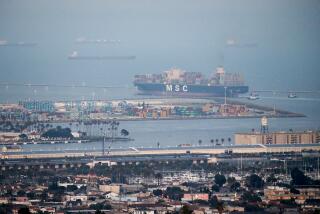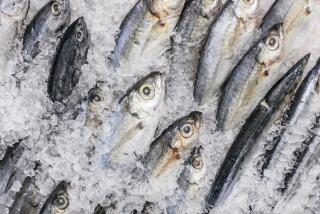Expanded Fishing Zone Creates Boom for U.S. Trawler Fleet
- Share via
SEATTLE — Ten years ago, the United States had virtually no factory trawler fleet that could harvest and process the riches of the open seas. The seas were dominated by foreign fishing vessels.
But with the help of federal legislation and a lot of capital investment, that situation has reversed.
A new report released by the Alaska Factory Trawler Assn. shows that the fleet that sails the North Pacific Ocean has become the largest in the nation and one of the largest in the world, making a significant contribution to the states of Washington and Alaska.
Aside from trumpeting its achievements, however, officials representing the fleet hope the numbers compiled by the accounting firm Coopers & Lybrand will throw some water on a political fire raging over the issue of who owns the fish in the waters off Alaska--Alaskans or those from the “Lower 49.”
According to the study, the fleet has experienced rapid growth since 1986, when there were 12 trawlers ranging in size from 130 feet to 340 feet worth an estimated $77 million.
By 1988, those numbers had grown to 43 vessels worth $520 million. This year the fleet consists of 57 ships worth $1.1 billion.
“This has become the biggest fleet in the nation,” said Bruce Buls, a spokesman for the Seattle-based Alaska Factory Trawler Assn. “The North Pacific is the bread basket of U.S. fisheries. There are other areas that are working, but many are on hard times. Nothing compares with the North Pacific.”
The fleet has accomplished its impressive growth with the help of the Magnuson Fishery Conservation and Management Act of 1976. The act extended U.S. fisheries jurisdiction to 200 miles off the coast of the United States, including Alaska and Hawaii.
Under the law, foreign vessels were gradually excluded from the 200-mile Exclusive Economic Zone, or EEZ. Today, the only foreigners allowed into the EEZ are those working in joint ventures with Americans.
U.S. commercial fishermen were slow at first to take full advantage of the opportunities presented by the Magnuson act, partly because Americans traditionally operated as independent fishermen in small boats pursuing high-value seafood such as salmon and crab.
But the Pacific salmon and crab industry had some hard years in the early 1980s, leading many fisherman to convert their vessels into trawlers for year-round work in the rich grounds of the Bering Sea and North Pacific.
It took investments of millions of dollars in new ships, conversions of existing vessels, and new processing plants, but the fleet was profitable by the late 1980s. The fish caught in the North Pacific, while relatively low in value, are in high demand around the world, particularly Asia.
In Alaska, the trawler fleet now accounts for about 9,700 direct and indirect jobs. In Washington, the fleet is responsible for 8,900 direct and indirect jobs.
Coopers & Lybrand said the factory trawler fleet contributes about $500 million annually to the Washington economy, or 56% of the $887 million total contribution to the state brought in by all commercial fishing. In King County, where much of the fleet is based, the factory trawlers will contribute an estimated $301 million this year.
The report did not have numbers for the fleet’s total economic contribution to Alaska’s economy, but said non-payroll expenditures this year are expected to be about $71 million.
More to Read
Sign up for Essential California
The most important California stories and recommendations in your inbox every morning.
You may occasionally receive promotional content from the Los Angeles Times.













